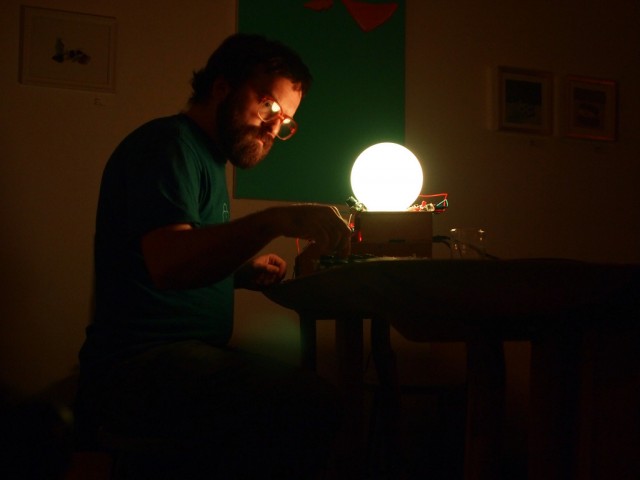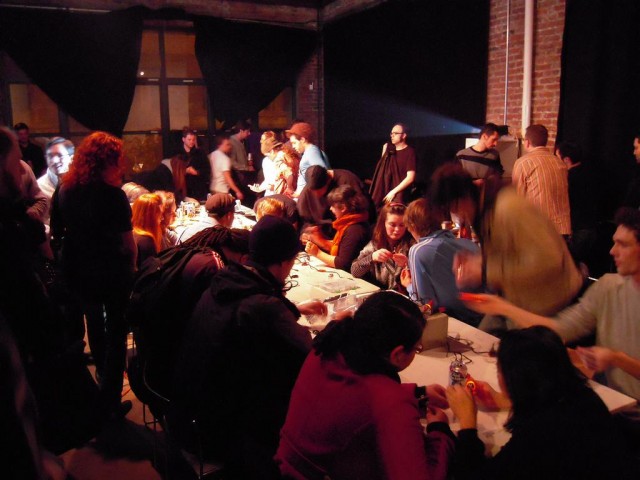Why DIY, anyway? As we prepare for a special Handmade Music afternoon hosted by Amsterdam’s STEIM research center, my co-curator Takuro Mizuta Lippit (dj sniff) asked me to answer that question. Here’s what I wrote for STEIM’s international Patterns and Pleasure festival.
“Do it yourself.”
In the world reshaped by recording, in which music is ubiqiutously available on demand and even bare-bones DJing qualifies as “live” entertainment, the act of just making music surely qualifies as “DIY.” Add the fact that distribution, promotion, and booking of music often falls increasingly on the artists themselves, and it’s hard to see any part of music that isn’t DIY.
So, given all that, what would drive artists to make or modify their own musical tools? One might as well ask why make music in the first place. (Because you can? Because it’s fun? Because it’s the most satisfying way to realize an idea or feeling – often the two together?) I believe some of the separation between “music” and “tools” or “gear” or “technology” is arbitrary. That independence is itself a recording-centric notion, in which musical content as artifact is imagined as independent from how it was made. During the process of production or performance, they’re inseparable. The evolution of musical practice, meanwhile, is intertwined with the technology of playing and representing music. Musical instruments in archaeological records appear alongside the first human tools. Those instruments, like the musical materials themselves, are vessels for expression of human thought. We can make our body an instrument, via percussion or voice, but as with so many other elements of our human life, we extend that body through invention.
When you play an instrument, whether a flute or an interactive music software patch, what you express is mediated both through musical language and the tool. I know as a child, it was what first drew me to music: I could press my fingers to the keys and hear something very much other than what I could produce myself. It’s easy to see the connection to the synthesizer and the computer.
When you want to realize (or discover) new musical and sonic ideas, then, it’s necessary to become involved with the way in which those sounds are produced. As composers for acoustic instruments and voice, you dive into the realms of harmony and rhythm, but also the mechanisms of the instruments and standard and extended techniques. Working with the computer, you employ interfaces – whether simulated knobs or code or graphical representation – to realize your ideas. With electronics, wires and resistors and diodes become compositional. With both, the container you fashion, the handcrafted cases or user interfaces, becomes part of the musical identity you design.
There is no such thing as an instrument built from scratch. To quote Isaac Newton (in words adapted by countless electrical engineers and computer scientists), “if I have seen further, it is by standing on the shoulders of giants.” We inherit a great body of knowledge and tooling. Whether a commercial DAW or a modular development environment or the circuit that makes a filter, we connect with the ideas, imagination, and expertise of generations of engineer-artists. Notably, we lost Max Mathews this year, whose lasting legacy, even more than breakthroughs in computer synthesis, may be his influence on decades of students and colleagues in chasing the limitless potential he saw in digital sound. Thought is the greatest technology there is.
I think we can easily become overly worried about the rise of digital tech. Computers and electronics are here, and for all their dangers – misuse and toxic waste being foremost among them – they are fundamentally a compilation of human ideas. If you like people, you’ll like computers and circuits when you get to know them. We can also become overly concerned with “new”; the great implication of the maturity of electronic sound technology to me is that we can begin to go from novelty to repeatability and expertise. That’s not to discount discovery; it’s simply that discovery can’t exist in a void. At the same time, in our appetite for mastery, we can devalue the novice. I’m excited by seeing projects that don’t quite work yet, that are only at the stage of technical demo or proof of concept, because to me it’s seeing the first steps on a path that could lead a musician into years of practice and refinement. It’s seeing the chicken popping out of the egg. Potential is stimulating when you believe it has a future.
Here, designing one’s own instruments is much like learning to play an instrument. You repeat the ideas of others, just as you repeat the sounds of others when you learn a musical scale. You make sounds that, at first, are, well, awful, but that then grow up. Whether arguably innovative or not, you make discoveries that are inherently personal. And the degree of that progression is dependent in large part on learning from others, playing with them and sharing their experience. As people share that experience, in the end there are breakthroughs to the genuinely new. Collective progress is what allows those individual eurekas.
With economies from Amsterdam to New Amsterdam slowing, with growing unfilled demand for the ability to actually make stuff and not just push abstract numbers around, and with technical problems that demand solutions literally to ensure our survival, all those strange noises we make take on a new meaning. Tools and technology enabled our civilization; now we need them to make humanity sustainable. Silly sounds and musicians’ racket and din may seem distant from that. But we can sing this necessity as a song. We can celebrate the spirit of experimentation by making things that make immediate noise. A bridge or a jet plane isn’t a great place for experimentation or on-the-job learning; music is the perfect playground because errors are always okay. If any community could help encourage free innovation in our culture, music is a strong candidate; today’s young synth builder could be tomorrow photo-voltaic breakthrough. And even if not, we’ll make a wonderful noise.
“Open source” and the “Web” are significant tools to make sharing expertise easier, but at the fundamental level, it’s simply “sharing” that matters. And this is where music’s makers and inventors are helping resurrect the principles of music as community. We have to share ideas and sounds to be able to move forward.
We do it ourselves, together.

